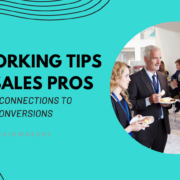Networking for Salespeople: 11 Steps For Achieving Personal & Professional Growth
For a good reason, networking for sales professionals has long been considered sage advice. This best practice can open up many doors for you, whether in friendships, mentorships, new career opportunities, and even earning referral sales opportunities.
But What Exactly Is Networking? (And How Should You Go About It?)
To network is to cultivate people around you who can help you professionally. This may come naturally to some, but for most, and especially for those who are more introverted, the task can seem much more daunting than it is appealing.
Becoming proficient at networking is synonymous with mastering the art of making friends. At the end of the day, we’re all human beings and, as such, tend to want to help one another. This is a more accurate sentiment when those who need help are befriended.
However, this is much easier said than done. To walk into a room full of strangers, confidently present yourself and quickly find relatable topics of conversation to build relationships is no easy task. After all, it’s not like we’re mind readers.
Here are a few tips you can lean on to help make the whole process of transitioning from strangers to friends a more welcoming ordeal.

Step 1: Prepare A Personal Pitch
The first thing you’ll want to do to get ready for a networking event is to prepare a personal pitch. Your personal pitch is a short but exemplary description of who you are and what you do.
After all, the question you’ll probably have to answer the most at any networking event is, “Who are you? And what do you do?”
Having a quick answer to these questions that is easy to comprehend is key to helping keep your interactions smooth. Stumbling through trying to explain who you are can come off as unconfident and leave a wrong initial impression.
Part of your pitch will be driven by your event goal, which is a perfect segue to our next piece of advice.
Step 2: Have A Goal In Mind
Networking, like many other life endeavors, can prove ineffective without a clear objective in mind. When approaching a networking event, try and think to yourself what it is you’d like to get out of it. Are you trying to find a mentor? Are you looking for prospects to drive future sales? Or are you simply trying to meet more people in a particular field? Having a specific goal in mind will help frame your interactions and conversations.
Let your goal be your mission, let that mission drive you, and let that be clear. Then, just as you understand who the people you meet are and what they’re doing, they’ll also begin to know what you’re looking to accomplish. Even if the person you’re talking to at that moment isn’t directly relevant to your goal, they may have just met someone or know someone in their network that can help you get to where you want to be.

Step 3: Have A Few Ice-breakers Prepared Ahead Of Time
Even the most socially adept people in the world are bound to have a few harmful interactions. Simply put, it’s impossible to be on top of your game 100% of the time. Maybe you’re drained from a long day at work, or perhaps something is pressing that suddenly pops into your mind at the wrong moment. Whatever the case, it’s very easy for us to become mentally distracted; for some, it only makes finding a conversation starter that much more difficult.
As such, to avoid that mental stress and save your energy for keeping engaged with the ongoing conversations, it’s a good idea to have some ice-breakers saved in your back pocket. That way, you can fall back on them without much thinking and get people talking quickly.
The rules of topics to avoid in the workplace also apply here. For example, you don’t want to argue with someone you’ve just met with if you’re trying to win their favor. That means you generally want to avoid talking about politics, religion, personal gossip, death, or the myriad of other topics that may be controversial.
If your mind is running blank, here are a few suggestions to get you started:
- Recent sporting events.
- Plans for the weekend.
- Reasons for attending the event.
- Advice on small challenges that you’re facing personally or at work.
- Listen intently.
It’s relatively easy for people to tell whether or not someone is genuinely listening to them. I’m sure we’ve all been guilty of this at some point, where we nod as someone is talking just to let them get out what they need to say, but we’re mentally checked out somewhere else. On the flip side, I’m sure we’ve been on the receiving end of this behavior at some point as well.
The moment someone realizes that you’re mentally checked out of the conversation, they’ll stop caring about you. Why? They probably feel you don’t care about them. So why should they take an interest in someone who isn’t reciprocating? Needless to say, it’s no way to make a good impression.
When someone is fully engaged in a conversation, there will be tell-tale signs that the person has been paying attention. Outside of body language, such as facing their direction and nodding your head, a good listener will occasionally rephrase parts of what they’re hearing and offer their thoughts on specific points. In addition, if you can relate some of the later topics of conversation to things mentioned earlier in the engagement, you’ll probably land a few bonus points there too.

Step 4: Bring A Friend
In fact, bring a few. Going to networking events as a group can offer several benefits over going alone. For one, as a group, you’ll be able to cover more ground because you guys have come as a unit. This inherently means that the group already understands each other’s objectives, increasing the chances that at least one of you will find the right person to connect with.
Secondly, you can leverage each other as a social crutch. For example, sticking together as a pack may draw others to grow your cluster and start conversations quickly. Additionally, because your group of friends is already familiar with one another, the rapport building amongst the group will probably feel more natural and suave, creating a comfortable environment for others to join.
Furthermore, interacting with strangers for an extended period can definitely prove to be a mentally draining activity. Therefore, if you need to take a break from all the action, you can rendezvous with your friends for some momentary relief.
Of course, there are many other things you could try to work on to improve your chances of making a great first impression, such as paying attention to the tonality of your voice and being conscious of your body language.
Why? Because we must emphasize how important it is to be aware of how we come across to other people when we first meet them. Your tonality and body language are some of the easiest things you can focus on if you’d like to get better at making an excellent first impression.
Just as you can use words to convey different meanings to compel people to feel specific ways, you can also use your body for that exact purpose. Through his research in 1971, Professor Mehrabian famously discovered the 7% rule, which is to say that words only contribute 7% to the importance of what is being conveyed. The other 93% comprises nonverbal elements such as body language and tonality; body language takes the lion’s share of that, with 55% and tonality accounting for the other 38%.
Step 5: Make Good, Solid Eye Contact
Working on eye contact is a quick and easy way to improve your body language. Though it may feel awkward for some, making eye contact is a great way to build rapport with someone you’ve just met quickly. Good eye contact conveys to the speaker that you are paying attention and are genuinely interested in what they have to say.
If you are one of those people who find making eye contact awkward or unnatural, as a general rule of thumb, where you want to be looking is the triangular area of a person’s face where their eyes and mouth act as the corners of that triangle. You also want to make sure that you’re breaking eye contact naturally with the flow of the conversation from time to time because otherwise, you might just come off as really creepy. You can even try focusing on one eye at a time and alternate between the two to see if it helps make things feel a bit less awkward.

Step 6: Practice Nodding Where Applicable
Another quick nonverbal tip that can win you some easy points is nodding as someone speaks. Just like eye contact, nodding indicates to the speaker that you understand what they are saying. This is somewhat of a mind trick, and feel free to test this out, but when someone starts nearing the end of what they intended to say, and you want to hear more, nod your head three times. This encourages them to elaborate further, which people often do.
Step 7: Remain Aware Of Your Body Orientation
Something else you might want to pay attention to is how you orient your body. For example, you generally want to be positioned so that your chest is facing the person you’re speaking to in a one-on-one engagement or towards the center of the group when in a group setting.
Even if you’re head is facing toward the individual you’re speaking to, if your torso is facing elsewhere, that person will get the sense that you are not giving them your full attention.
Slightly more advanced is ensuring that your feet are correctly oriented. Again, you want your feet to generally point in the direction of the person you are speaking to or towards the center of the group in a group context. Feet can say a lot about people’s intentions. When someone is about to leave a conversation, you can often tell because their feet will turn in the direction they intend to go before the rest of their body.
Step 8: Keep a Good Posture
Confidence is a massive part of making a good impression. When people congregate together in a room, it’s not the coy individuals on the side that everyone notices. No. The confident individuals in the center of the room catch people’s attention.
A good posture is one of the best ways to convey confidence. That means keeping your back straight and chin up. If you’re someone who happens to slouch often, trying to fix your posture can understandably feel awkward. Furthermore, some people may find even overcorrecting and strain their backs in a forced effort to keep it straight. You definitely want to use your back muscles to support your weight but not to the point where you feel uncomfortable when holding your form.
Also, keeping your chin high means not tucking in your chin too often. Someone constantly looking at the floor or otherwise in a downward direction comes off to others as shy and unconfident, which is the exact opposite of the message you want to send. This also shouldn’t be overdone to the point where you’re looking down on people, but it is something that you’ll want to pay closer attention to.

Step 9: Use Reciprocal Tonality
It’s not likely that this is a term you’ll find being used elsewhere, but the idea represents the use of tone to respond appropriately to what is being said. For example, if someone just told you about a fantastic weekend they had, it would be an excellent opportunity for you to add some excitement to your voice. This lets the speaker know they’re doing a fantastic job sharing their experience and makes them feel better being listened to.
Getting this wrong could significantly hurt your chances of making an excellent first impression. Not that I’d imagine anyone to do this, but if someone were to tell you they were ill, a proper response would not be to respond with, “Hey, that’s great!” Failing to respond appropriately could lead to a very awkward situation, so be mindful of how you respond.
Step 10: Have A Strong Voice
Again the goal in your interactions should be to come off as being confident. In addition to having good posture, another way to demonstrate that you are indeed a confident individual is to have a strong voice. As with all of the advice thus far, moderation is key.
You want to be loud enough to easily be heard by those you are speaking to but not so loud that you’re basically screaming at people. On the other hand, being too loud or soft in your speech can irritate some people. No one likes to be yelled at, and there’s nothing more frustrating than putting in more effort to try and make out what someone is saying.
Follow the Goldilocks Principle and find that perfect medium that will pave the path for you to sound like a complete rockstar.

Step 11: Use Hand Gestures Thoughtfully
Lastly, using your hands can be a great way to help make a lasting impression. Using your hands will allow you to be much more expressive in communicating your thoughts and enable others to remember what you’re saying more easily.
When using your hands to communicate, you want your gestures to match what’s being said. For example, when describing something small, a pinching gesture could do well to accompany your message.
Gesturing also helps you convey a sense of enthusiasm and confidence, which is precisely what you want to do when trying to network.
So, as a quick recap, you want to pay attention to eye contact, nods, posture, tone, volume, and hands. It may be a bit much to try and improve on all of these areas all at once, so I recommend focusing on just 1 or 2 at a time. Then, once you feel well-mastered in one place, move on to the next until you become a networking virtuoso.
Need help growing your network and connecting with potential employers? Join Rainmakers now!











Trackbacks & Pingbacks
[…] This blog post is actually a continuation of a previous blog post on how you can improve your networking abilities. If you haven’t already read the first part of this series, check it out here. […]